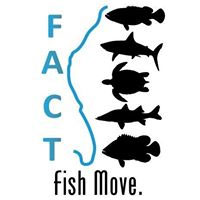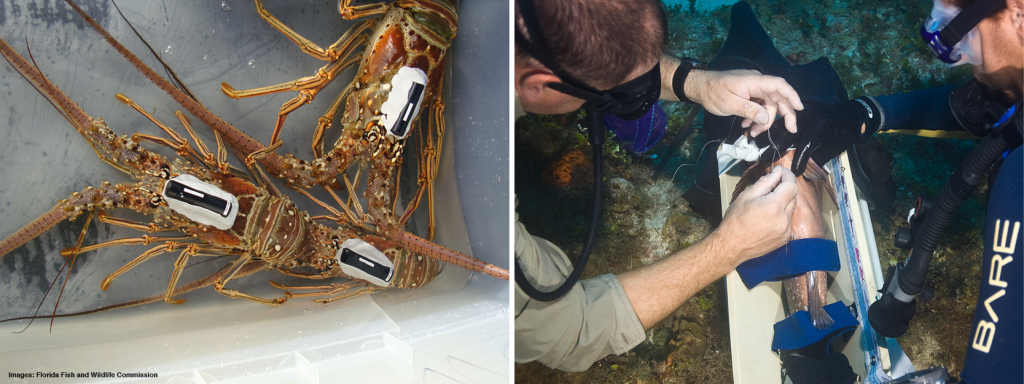Project Overview
Effective fisheries management incorporates knowledge across many topics: connectivity between habitats, trophic interactions, the importance of spawning aggregations, and movement of marine species. The complexity of the Florida Key’s Reef Tract, with a vast array of habitats (coral reefs, seagrass beds, mangroves), are used by many marine animals. One tool that The Florida Fish and Wildlife Conservation Commission (FWC) uses to help manage marine resources in the Florida Keys is acoustic telemetry.
Acoustic telemetry can provide a unique opportunity to study animal movement and behavior. Both the Finfish and Lobster Research Teams in the South Florida Regional Lab of FWC have been maintaining acoustic arrays throughout the Florida Keys Reef Tract for over a decade. By using acoustic transmitters to monitor reef fish species, FWC has evaluated the movement ecology of various reef fish inhabitants including snappers, groupers, lionfish, and hogfish. FWC has also examined the movements of some non-fish species such as spiny lobster and queen conch. By working in collaboration with other organizations, the FWC’s long-term monitoring arrays have shared data on many other species including permit, tarpon, cobia, parrotfish, sawfish, sharks, rays and sea turtles, just to name a few.
This project aims to understand:
- How movement patterns vary between reef species, such as the size of a home range, habitat use preferences, and possible migration patterns
- What are the timing, distance, and duration of movements related to spawning behavior
- Do patterns of connectivity exist between protected and non-protected marine areas
- What factors influence movement patterns, such as seasonality, lunar cycle or other environment conditions
Animal tracking consists of two parts. The first part of animal tracking is tagging the animal. For reef fish species, FWC scientist have refined a method that involves tagging the fish underwater. Scientists use fish traps to capture the targeted species and then dive underwater to implant an acoustic tag in the abdominal cavity of the fish. This animal is released immediately into the surrounding sheltering habitat. For animals such as the spiny lobster, tags are externally attached to the carapace using a special marine epoxy.
The second part of tracking an acoustically tagged animal is maintaining underwater acoustic receiver stations that will collect information from a tagged animal when it swims by. The acoustic array maintained by FWC and partners in the Florida Keys is comprised of over 170 receivers and stretches from Key Largo to Dry Tortugas National Park.
Why this Matters
Data gained from this project provides better knowledge on reef species habitat use, spawning behavior, and different factors influencing the movement behavior of these species in the Florida Keys. With this information managers can make better decisions for the future management of these species within the Florida Keys.
Lead Organizations
- Finfish Research Team
- South Florida Regional Lab
- Fish and Wildlife Institute
- Florida Fish and Wildlife Commission
Partners
- The Florida Keys National Marine Sanctuary
- Bonefish and Tarpon Trust
- The FACT Network
- iTAG
- University of Massachusetts
- Clemson University
- Florida Atlantic University
- Florida International University
- University of Puerto Rico
Supported by
Funding for the FWC Florida Keys acoustic telemetry projects have been provided by the following:
- The National Oceanic and Atmospheric Administration
- The Florida Keys National Marine Sanctuary
- The National Park Service
- The U.S Fish and Wildlife Service
- The U.S. Environmental Protection Agency
- Fish and Wildlife Foundation of Florida, Inc.
Project Status
- Ongoing; with the acoustic arrays changing over time as new research questions are addressed
- FACT Project Codes:
- FLKEYST (tags)
- FLKEYS (array)
- FACT Project Codes:
Contact
Resources & Publications
Citations from the South Florida Regional Lab:
- Keller JA, Herbig JL, Morley D, Wile A, Barbera P, Acosta A. 2020. Grouper tales: Use of acoustic telemetry to evaluate essential fish habitat in the Florida Keys. Marine and Coastal Fisheries
- Herbig J, Keller J, Morley D, Walter K, Acosta A, Barbera P. 2019. Examining movement patterns of yellowtail snapper, Ocyurus chrysurus, in the Dry Tortugas, Florida. Bulletin of Marine Science 95(1):45-67.
- McCallister M, Renchen J, Binder B, Acosta A. 2018. Diel activity patterns and movement of invasive lionfish (Pterois volitans/P. miles) in the Florida Keys identified using acoustic telemetry. Gulf and Caribbean Research, 29(1), pp.27-40.
- Feeley MW, Morley D, Acosta A, Barbera P, Hunt J, Switzer T, Burton M. 2018. Spawning migration movements of mutton snapper in Tortugas, Florida: Spatial dynamics within a marine reserve network. Fisheries Research 204:209-223.
- Bertelsen RD. 2013. Characterizing daily movements, nomadic movements, and reproductive migrations of Panulirus argus around the Western Sambo Ecological Reserve (Florida, USA) using acoustic telemetry. Fisheries Research 144:91-102.
- Bertelsen RD, Hornbeck J. 2009. Using acoustic tagging to determine adult spiny lobster (Panulirus argus) movement patterns in the Western Sambo Ecological Reserve (Florida, United States). New Zealand Journal of Marine and Freshwater Research 43: 35-46.
- Delgado GA, Glazer RA. 2007. Interactions between translocated and native queen conch Strombus gigas: evaluating a restoration strategy. Endangered Species Research 3:259-266.
- Glazer RA, Delgado GA, Kidney JA. 2003. Estimating Queen Conch (Strombus gigas) home ranges using acoustic telemetry: implications for the design of marine fishery reserves. Gulf and Caribbean Research 14(2):79–89.
Citations from Telemetry Partnerships:
- Brownscombe JW, Griffin LP,Morley D, Acosta A, Hunt H, Lowerre-Barbieri SK, Crossin GT, Iverson SJ, Boucek R, Adams AJ, Cooke SJ, Danylchuk AJ. 2020. Seasonal occupancy and connectivity amongst nearshore flats and reef habitats by permit Trachinotus falcatus: considerations for fisheries management. Journal of Fish Biology 96:469-479.
- Young JM, Bowers ME, Reyier EA, Morley D, Ault ER, Pye JD, Gallagher RM, Ellis RD. 2020. The FACT network: philosophy, evolution, and management of a collaborative coastal tracking network. Marine and Coastal Fisheries 11:1-14.
- Brownscombe JW, Griffin LP, Chapman JM, Morley D, Acosta A, Hunt J, Crossin GT, Iverson SJ, Adams AJ, Cooke SJ, Danylchuk AJ. 2020. A practical method to account for the variation in detection range in acoustic telemetry arrays to accurately quantify the spatial ecology of aquatic animals. Methods in Ecology and Evolution 11:82-94.
- Boucek RE and Morley D. 2019. Demonstrating the value of cross-ecosystem syntheses and comparisons in animal movement and acoustic telemetry research. Fisheries Research 216: 74-78.
- Brownscombe JW, Adams AJ, Young N, Griffin LP, Holder P, Hunt J, Acosta A, Morley D, Boucek R, Cooke SJ, Danylchuk AJ. 2019. Bridging the knowledge-action gap: A case of research rapidly impacting recreational fisheries policy. Marine Policy 104:210-215.
- Pratt HL, Pratt TC, Morley D, Lowerre-Barbieri S, Collins A, Carrier JC, Hart KM, Whitney NM. 2018. Partial migration of the nurse shark, Ginglymostoma cirratum, (Bonnaterre), from the Dry Tortugas Islands. Environmental Biology of Fish 101:515-530.
- Hart KM, AR Sartain, Fujisaki I, Pratt HL, Morley D, Feeley MW. 2012. Home range, habitat-use, and migrations of hawksbill turtles tracked form Dry Tortugas National Park, Florida, USA. Marine Ecological Progress Series 457: 193-207.

